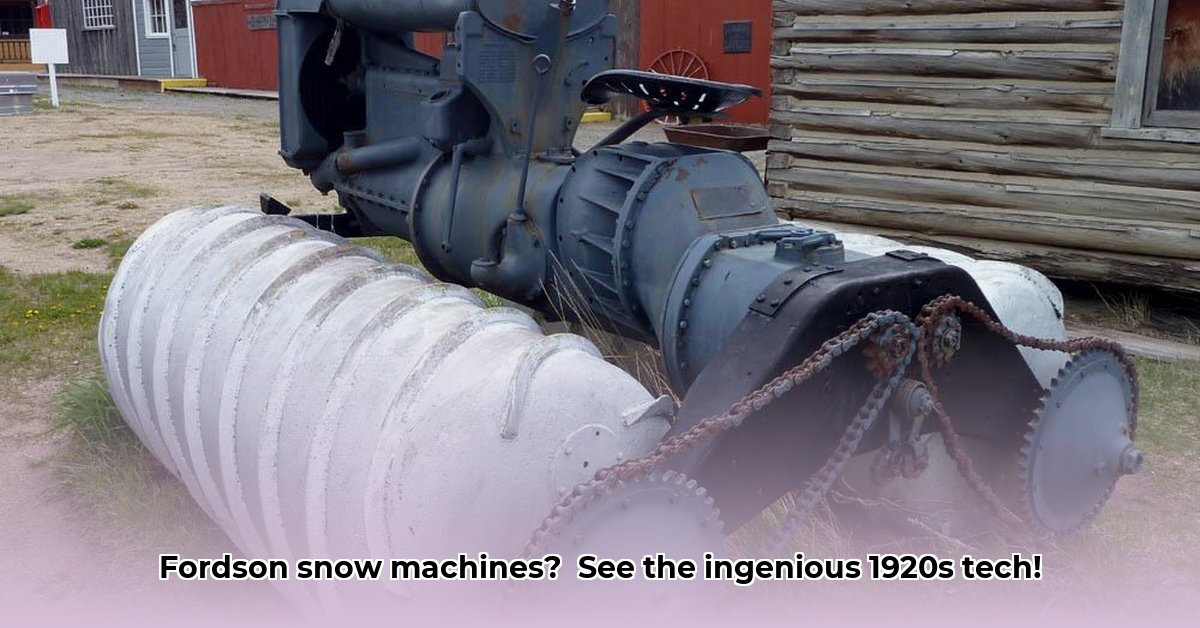
Imagine the unforgiving landscape of the 1920s: blizzards burying vast stretches of land under mountains of snow. Transportation, especially in remote logging areas, was a monumental challenge. Yet, amidst the swirling snow, a surprising solution emerged: the Fordson tractor, ingeniously converted into a powerful snow machine. These weren't sleek, purpose-built snowmobiles; they were robust farm tractors, creatively reimagined for winter's harshest conditions. Their capacity to haul astonishing loads—sometimes up to twenty tons of timber—through deep snowdrifts is a testament to the ingenuity of the era. For more on Fordson tractors, see this useful resource. This article will delve into the history, mechanics, and lasting legacy of these remarkable machines.
From Farm Fields to Frozen Forests: The Transformation
Converting a Fordson tractor into a snow machine wasn't a mere bolt-on modification; it was a fundamental redesign. The crucial innovation was the addition of massive pontoons—large, buoyant platforms—attached to the chassis. These pontoons allowed the heavy tractor to float on top of the snow, preventing it from sinking and drastically improving its mobility in deep drifts. While images from the period show these adaptations as somewhat crude, they were remarkably effective. They represented a blend of rugged practicality and resourcefulness—a pragmatic response to the harsh realities of winter in remote areas. These weren't elegant machines; they were functional, powerful, and built to withstand the extreme demands of the icy wilderness.
Under the Hood (and Underneath!): The Technical Aspects
While precise blueprints are scarce, the fundamental principles are clear. The Fordson's robust engine, already known for reliability, provided the power. The pontoons, likely constructed from readily available materials such as wood or metal, offered the necessary flotation. The true technical challenge lay not merely in design, but in the demanding process of construction. Imagine the immense effort of building these huge pontoons, securely attaching them to the tractor frame, and ensuring the entire structure could withstand the brutal impacts of hauling heavy loads across uneven, snow-covered terrain. The level of ingenuity involved in this adaptation should not be underestimated.
Driving the Beast: Operational Challenges and Triumphs
Operating a Fordson snow machine wasn't a leisurely affair. Reports suggest a top speed of around 8 mph – hardly impressive by today's standards! Maneuverability was likely a considerable challenge, and conducting repairs in remote logging camps must have been fraught with difficulties. Despite these limitations, these converted tractors were undeniably invaluable. Their ability to transport massive quantities of logs – up to twenty tons, according to some accounts – through deep snow was unmatched in that era. They became essential tools in the logging industry, providing a critical lifeline in otherwise inaccessible areas. Did these limitations hinder their wider adoption? Let's explore that further.
Why Didn't Fordson Snow Machines Become Ubiquitous?
Despite their impressive performance in specialized environments, Fordson snow machines never achieved widespread adoption. Their comparatively slow speed and limited maneuverability, coupled with the technological limitations of the time, confined their use to niche applications. The subsequent development of more advanced snow vehicles and improved road networks quickly rendered them obsolete. However, their significance as pioneering early snow vehicles remains undeniable. Their legacy is not one of mass market success, but of creative adaptation and problem-solving in the face of extreme challenges.
A Legacy of Ingenuity and Adaptation
The Fordson snow machine stands as more than just a clever piece of engineering; it's a powerful symbol of ingenuity and adaptability. Facing significant challenges, resourceful individuals devised creative solutions. While their era was relatively short, their impact on the early development of snow vehicles endures, a testament to human resilience and innovation. Their story inspires further exploration and investigation; they represent a fascinating intersection of agricultural technology and frontier ingenuity. The possibility of restoring or recreating these impressive machines, leveraging modern materials and engineering principles, holds considerable appeal for enthusiasts and historians alike. This could even spark renewed interest in the development of such specialized vehicles for niche applications today.